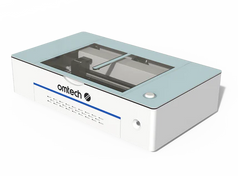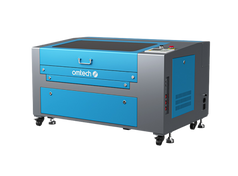Selecting the Correct Safety Eyewear for Laser Engraving

Laser engraving is a popular technique that uses high-intensity light beams to etch various materials. While this method produces precise and beautiful results, it can also pose serious risks to your eyes if you are not properly protected. It is crucial to wear the appropriate safety glasses to shield your eyes from harm while working with lasers.
The Significance of Laser Safety Glasses
Laser safety glasses play a vital role in safeguarding your eyes from potential damage caused by high-powered laser beams. These glasses filter out harmful wavelengths emitted by lasers like CO2 and fiber, protecting your eyes from direct exposure to the laser beam and hazardous reflections. In addition to ensuring compliance with industry standards set by OSHA, wearing safety glasses promotes a culture of safety in the workplace and reduces the risk of eye injuries.
Key Factors to Consider When Choosing Safety Glasses for Laser Engraving
When selecting safety glasses for laser engraving, it is essential to consider several factors to ensure optimal protection:
Laser Wavelength and Lens Material Compatibility
Different types of lasers operate at specific wavelengths and emit light across a spectrum ranging from ultraviolet to infrared. It is crucial to choose safety glasses that block the specific wavelength range of the laser you will be using. While polycarbonate lenses offer broad-spectrum protection, they may not be suitable for all laser types. Glass or mineral lenses provide better visibility and protection against certain wavelengths.
Optical Density (OD) and Laser Power
Optical density (OD) is a measure of how effectively the glasses reduce the power of the laser beam to a safe level for your eyes. A higher OD indicates greater attenuation, meaning that more laser power is being reduced. The recommended OD for your safety glasses can usually be found in the laser system's manual, which will also contain information about the laser's specifications and power output.
Frame Design and Comfort
Since you may be wearing safety glasses for extended periods, it is essential to prioritize comfort when selecting a frame design. Look for lightweight yet sturdy frames that offer adjustability features such as nose pads or temples that can be customized for a better fit. It may be necessary to try on multiple pairs of glasses to find the right balance between comfort and safety.
Additional Protective Features
In addition to the essential factors mentioned above, some safety glasses offer additional protective features to enhance laser safety, such as anti-fog coatings for increased visibility in humid conditions, side shields to protect against laser radiation from different angles, scratch-resistant coatings for lens protection, high-contrast filters for improved vision, and designs that can be worn over prescription eyewear.
Types of Laser Safety Glasses: CO2, Fiber, and Beyond
Depending on the type of laser system you are using, you may require specific safety glasses tailored to the laser's wavelength and power output:
CO2 Laser Safety Glasses
CO2 lasers typically operate in the far-infrared region, with a wavelength around 10,600 nanometers (nm). These lasers are commonly used in engraving, cutting, and welding applications. Safety glasses designed for CO2 lasers often utilize materials such as polycarbonate or specialized composite blends that effectively block or reduce infrared radiation. These glasses have a high OD to handle the higher power levels typically emitted by CO2 lasers.
Fiber Laser Safety Glasses
Fiber lasers operate at wavelengths around 1,064 nm, but their range can extend from 1,000 to 1,100 nm. These lasers are commonly used in metal marking, engraving, and medical procedures. Safety glasses for fiber lasers typically feature glass lenses, as they provide better protection against these specific wavelengths. Glass lenses offer high OD levels and superior visibility compared to polycarbonate lenses at these wavelengths.
Specialized Safety Eyewear for Specific Applications
Aside from CO2 and fiber lasers, various other specialized laser applications require specific safety glasses tailored to their unique requirements. Some examples include diode lasers used in pointers and medical equipment, YAG lasers utilized in medical and industrial settings, excimer lasers employed in eye surgeries and semiconductor manufacturing, and holmium lasers utilized in medical procedures.
Compliance with Industry Standards for Safety Glasses
When purchasing laser safety glasses, ensure that they meet industry compliance and certification standards to guarantee their effectiveness and reliability. Safety glasses undergo testing for their ability to withstand exposure to direct laser beams of various intensities and wavelengths. Once a pair of safety glasses passes these tests, they are typically marked with the standard they comply with, as well as the specific laser wavelengths and optical densities they are certified for. Common compliance and certification markers include:
- American National Standards Institute (ANSI) Z87 and 136
- European Union standards EN 207 and EN 208
Tips for Maximizing Laser Safety
In addition to selecting the appropriate safety eyewear, it is important to care for and maintain your glasses properly and ensure a safe working environment:
Proper Use and Maintenance of Safety Glasses
- Ensure that the safety glasses fit securely around your eyes to prevent laser radiation from entering through gaps.
- Inspect the glasses before each use for scratches, cracks, or other damage that could compromise their effectiveness.
- Clean the lenses with a suitable lens-cleaning solution and a soft cloth designed for optical surfaces, avoiding abrasive cleaners that could damage the lens.
- Store the safety glasses in a protective case to prevent accidental damage and avoid leaving them exposed in a laser work area.
Creating a Safe Working Environment
- Display appropriate warning signs in all laser areas to alert workers and visitors about the presence of lasers and the need for eye protection.
- Utilize laser barriers or curtains to block or absorb laser light and prevent it from exiting the work area.
- Provide comprehensive training to all staff who work with or around lasers on potential hazards and safety protocols, especially when introducing new equipment.
- Regularly inspect laser equipment to ensure it is in good working condition, including alignment, safety interlocks, and emergency shut-off systems.
- Develop and implement standard operating procedures for using laser equipment, outlining emergency protocols in case of an incident.
- Restrict access to the laser-operating area to authorized personnel who have received appropriate training.
- Establish an emergency response plan that includes first-aid procedures in the event of laser exposure, ensuring that all staff are familiar with the plan.
Enhancing Laser Safety with the Right Engraving Machine
In addition to wearing protective equipment and adhering to safety guidelines, selecting the appropriate laser engraving machine is essential for maintaining a safe working environment. OMTech provides high-quality laser machines that adhere to industry standards and are designed to be user-friendly, making them suitable for both beginners and experienced users. Contact us today to discover how our laser machines can help you achieve your engraving goals while prioritizing safety and efficiency.























